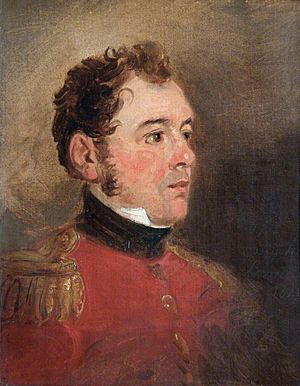James Shaw Kennedy facts for kids
General Sir James Shaw Kennedy (born 13 October 1788 – died 30 May 1865) was a brave British soldier and a skilled writer about military topics. He served in many important battles and helped shape police forces.
Contents
Early Life and First Battles
James Shaw Kennedy was born in Dalton, Scotland. His father was a captain in the army. James went to school at Ayr Academy. In 1805, he joined the 43rd Light Infantry, a famous army regiment.
His first experience in battle was in 1807 during the Copenhagen Expedition. As a lieutenant, he also fought in the Corunna Campaign. During the army's difficult retreat from Corunna, Shaw and his regiment bravely fought at the back to protect the other soldiers. After this, he became very sick.
In 1809, Shaw returned to the war in Portugal and Spain. He marched 250 miles with his regiment to the Battle of Talavera. There, he became the adjutant, a key assistant, for his regiment.
A Brave Military Career
From 1809 to 1810, Shaw worked as an aide-de-camp for General Robert Craufurd. This meant he was a personal assistant to the general. He helped write important rules for the Light Division, a special army unit.
He was hurt at the Siege of Almeida in 1810. But he rejoined General Craufurd and was with him at the Siege of Ciudad Rodrigo in 1812. During a big attack, Shaw bravely carried his badly wounded general off the battlefield. He also delivered a message from the Duke of Wellington asking the French to surrender.
At the Battle of Badajoz, Shaw showed great courage. He was promoted to captain in July 1812. Later that year, he had to go back to England because he was ill.
In 1815, Shaw returned to active service. He fought at the famous Battle of Waterloo on 18 June 1815. He was an assistant quartermaster-general, helping with supplies and troop movements. During the battle, he was hit and one of his horses was killed. His smart planning helped General Alten and the Duke of Wellington. For his bravery, he was promoted to brevet major and later to brevet lieutenant-colonel.
After the war, from 1815 to 1818, Shaw was in charge of the city of Calais in France. When he returned to England, he worked as a staff officer in the north. He helped deal with the Manchester riots in 1819, which were protests by unhappy workers.
Working in Manchester
In 1826, Shaw was sent to Manchester. For the next nine years, he helped manage several public protests. These protests happened because many people were unhappy with their working conditions.
Leading the Police Force
In 1829, Shaw was offered a top job with the new Metropolitan Police in London, but he turned it down.
From 1836 to 1838, he became the inspector-general of the Royal Irish Constabulary (RIC). This was a police force in Ireland. He was responsible for creating and organizing a force of 8,000 men. After this, he lived a quiet life in the countryside for ten years.
Later Challenges and Recognition
In 1848, during the Chartist movements (a time of political protest), Shaw Kennedy was called to command troops in Liverpool. He was later offered commands in Ireland and Mauritius, but his health problems forced him to decline. He briefly took a command in Scotland but again had to retire due to illness.
In 1852, a famous officer named Sir William Napier said that Shaw Kennedy was "perhaps... the very ablest officer in the service."
Shaw Kennedy continued to receive promotions. He became a lieutenant-general in 1854 and a full general in 1862. He also received important awards like the Knight Commander of the Order of the Bath (KCB). He earned medals for his service in the Peninsular War and the Battle of Waterloo.
Sir James Shaw Kennedy passed away in Bath, England, on 30 May 1865, after a long illness.
Family Life
In 1820, James Shaw married Mary Primrose Kennedy. They had one son and two daughters. In 1834, he added "Kennedy" to his last name because his wife inherited the Kirkmichael estate.


